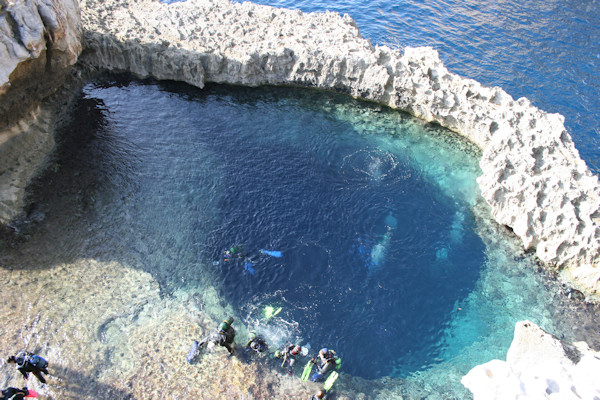Incredible geographical phenomenon known as Blue Hole.
located 60 miles off the mainland of Belize.
In this world there are many blue holes, but not as stunning in Belize.
The surface of this hole diameter of 0.25 miles, with depths reaching 145 meters.
People can dive in this hole.
The Great Blue Hole is a huge drain on the coast of Belize. It lies near the center of Lighthouse Reef, a small atoll 60 miles (96 kilometers) east of mainland Belize. The hole is perfectly round shape, more than 1,000 feet (305 meters) and depth of 480 feet (146 meters).

Lighthouse Reef Atoll Blue Hole
Mystery of the Great Blue Hole The Famous And Life In The depth
The Blue Hole is the result of the repeated collapse of a limestone cave system formed during lower sea level at the time of the trip last ice age.
Extraordinary geographical phenomenon is one of the most amazing dive sites in the world, made famous by Jacques-Yves Cousteau who declared it was one of the best scuba diving from the four best sites on Earth. In 1971, he brought the ship Calypso and submarine into the hole to the depth chart and examine stalactites suspended from a wall hanging.
Contrary to rumors, did not lose his son Philippe Cousteau here – he died elsewhere in a helicopter crash. Cousteau also did not use explosives to destroy the navigation patch reefs at Calypso in the Blue Hole.
Indigo blue color depth is created that causes such a structure known as the ‘blue hole.
Pederson’s cleaning shrimp that inhabit the ubiquitous and prominent surrounded by anemones, and neon gobies advertise their cleaning services from various coral heads. Angelfish, butterflyfish, hamnlets, and small groupers are also commonly seen. Elkhorn coral grows to the surface and purple seafans sweep at the calm water surface, they seem rich shimmering colors.
The walls are thinner than the surface to depths of about 110 feet (44 meters) where you begin to encounter stalactite formations which actually angle back, allowing you to dive under the overhang horrible. Water movement and visibility approaching 200 feet (61 meters).
Regions deeper inside the Blue Hole does not have abundant life because of the walls that limit, resulting in a lack of water circulation and light.
The locals feel this should be one of the Seven Wonders of the World. And now protected by the Belize Audubon Society and the Belize National Monument. It became a World Heritage site in 1997

A major earthquake would cause the cave ceiling to collapse forming the sinkhole, and the turbulence has the effect of Lighthouse Reef tilted to an angle of about 12 degrees. Along the walls of this cave is a former overhangs and ledges, housing Pleistocene stalactites, stalagmites, and columns.
Evidence for this is the edge of the shelf and carved in limestone by the sea, which run the full interior circumference of the Blue Hole at various depths. The first of these edges are found between 150 and 165 feet (45-50 meters) and the most visited on the south side.
A deeper dive into the Blue Hole, clear water and the scenery more stunning, as an array of bizarre stalactites and limestone formations that form the walls become more complex and intense.
On the west side at a depth of 230 feet (70 meters), there is the entrance through a narrow tunnel into the cavern. Total darkness, stalactites, stalagmites and columns exist in the world is not disturbed.
The floor is covered with very fine silt waves into great clouds with a slight movement of the diver who was passing. In the farthest corner, another narrow hallway that leads upwards into a cave and the other, emharah to the cave 2 and 3, where there are skeletal remains of turtles that never found a way out of it ..
Some of the tunnels are thought to be connected directly to the mainland, although it was never conclusively proven. Mainland also has a lot of holes filled with water that is connected to the caves and tunnels.
2-foot long laminated sediment cores revealed that circulated during the study by Robert F. Dill and divers from the Cambrian Foundation in 1997. There is no oxygen near the bottom, and hydrogen sulfide to prevent occupants underwater digging and disturbing the sediment.
Preliminary analysis of short cores show fluctuating pollen, spores, mercury, and arsenic levels ranged between 15 and 21 ppm (parts per million). Other events recorded in the short cores including hurricane or major storm layers. Hurricane bright and beautiful layers.


The temperature at a depth of 130 feet (40 meters) is about 76 degrees F (24 C) throughout the year.
Lighthouse Reef, an atoll about 25 miles long and 10 wide 12 miles, has a typical enclosed lagoon. The depth of these lagoons varies 5-25 feet (1.5 to 7.5 meters), where many scattered coral formations known as a patch that is found inside.
source: http://looking-news.blogspot.com/2010/03/misteri-great-blue-hole-yang-terkenal.html
No comments:
Post a Comment